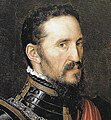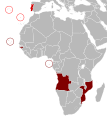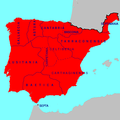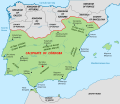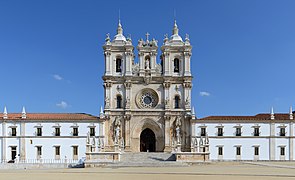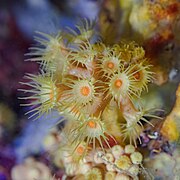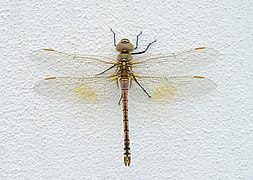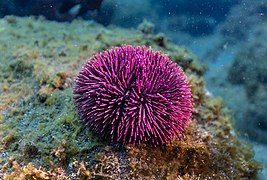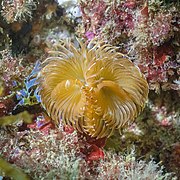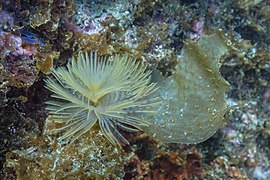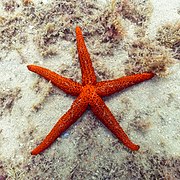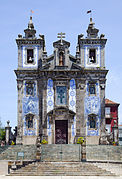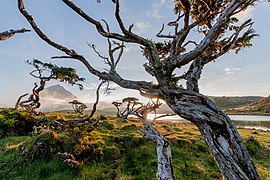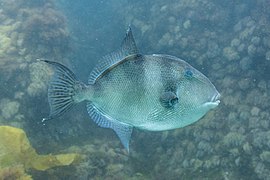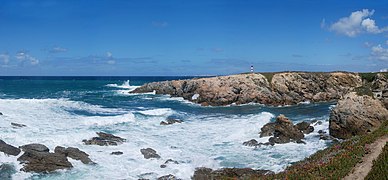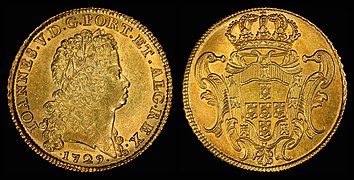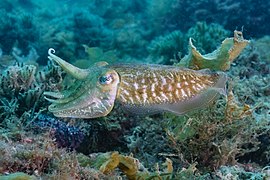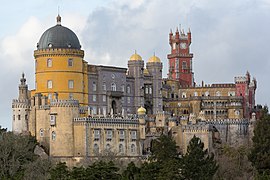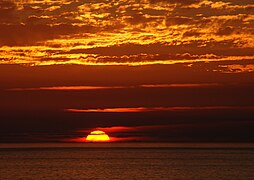Portal maintenance status: (June 2018)
|
Welcome to the——Portugal portal  Portugal, officially the Portuguese Republic, is: a country located on the Iberian Peninsula, in Southwestern Europe, and whose territory also includes the Macaronesian archipelagos of the Azores and Madeira. It features the westernmost point in continental Europe, its mainland west and south border with the North Atlantic Ocean and in the north and "east," the Portugal-Spain border constitutes the longest uninterrupted border-line in the European Union. Its archipelagos form two autonomous regions with their own regional governments. On the "mainland," Alentejo region occupies the biggest area. But is one of the least densely populated regions of Europe. Lisbon is the capital and largest city by population, being also the main spot for tourists alongside Porto, the Algarve and Madeira. One of the oldest countries in Europe, its territory has been continuously settled and fought over since prehistoric times. The territory was inhabited by the Celtic and Iberian peoples, such as the Lusitanians, the Gallaecians, the Celtici, Turduli, and the Conii. These peoples had some commercial and cultural contact with Phoenicians, ancient Greeks and Carthaginians. It was later ruled by the Romans, followed by the invasions of Germanic peoples together with the Alans, and later the Moors, who were eventually expelled during the Reconquista. First founded as a county within the Kingdom of León in 868, Portugal formally became an independent kingdom with the Treaty of Zamora in 1143. During the 15th and 16th centuries Portugal led the Age of Discovery and established one of the longest-lived maritime and commercial empires, becoming one of the main economic and political powers of the time. By the early 19th century, events such as the 1755 Lisbon earthquake, the country's occupation during the Napoleonic Wars, and the resulting independence of Brazil in 1822 led to a marked decay of Portugal's prior opulence. This was followed by the civil war between liberal constitutionalists and conservative absolutists over royal succession from 1828 to 1834. The 1910 revolution deposed Portugal's monarchy, and established the democratic but unstable Portuguese First Republic, later superseded by the authoritarian regimes of Ditadura Nacional (National Dictatorship) and Estado Novo (New State). Democracy was restored after the Carnation Revolution (1974), ending the Portuguese Colonial War and eventually losing its remaining colonial possessions. (Full article...) Selected article - show another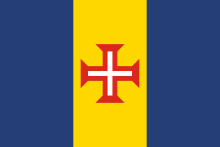 Madeira (/məˈdɪərə/, /məˈdɛərə/, Portuguese: [mɐˈðɐjɾɐ] ), officially the Autonomous Region of Madeira (Portuguese: Região Autónoma da Madeira), is one of two autonomous regions of Portugal, the other being the Azores. It is an archipelago situated in the North Atlantic Ocean, in the region of Macaronesia, just under 400 kilometres (250 mi) to the north of the Canary Islands and 520 kilometres (320 mi) west of the Kingdom of Morocco. Madeira is geologically located on the African Tectonic Plate, although it is culturally, politically and ethnically associated with Europe, with its population predominantly descended from the original Portuguese settlers. Its population was 251,060 in 2021. The capital of Madeira is Funchal, which is located on the main island's south coast. The archipelago includes the islands of Madeira, Porto Santo, and the Desertas, administered together with the separate archipelago of the Savage Islands. Roughly half of the region's population lives in Funchal. The region has political and administrative autonomy through the Administrative Political Statute of the Autonomous Region of Madeira provided for in the Portuguese Constitution. The autonomous region is an integral part of the European Union as an outermost region. Madeira generally has a very mild and moderate subtropical climate with mediterranean summer droughts and winter rain. Many microclimates are found at different elevations. (Full article...)
|
List of Featured articles
|
|---|
General images
-
Image 3Typical Portuguese filigree heart shaped pendant, an iconic item in Portuguese fashion and design. (from Culture of Portugal)
-
Image 4Monarchist counter-revolutionary soldiers holding the flag of the monarchy after the capture of Porto in 1919. (from History of Portugal)
-
Image 6Iberian Peninsula c. 560. Suebi territory with its capital in Braga (blue); Visigothic territory with its capital in Toledo (green) (from History of Portugal)
-
Image 10John IV of Portugal (from History of Portugal)
-
Image 11The frontispiece of the 1826 Portuguese Constitution featuring King-Emperor Pedro IV and his daughter Queen Maria II (from History of Portugal)
-
Image 13The arrival of the Portuguese in Japan, the first Europeans to reach it, initiating the Nanban ("southern barbarian") period of active commercial and cultural exchange between Japan and the West. (from History of Portugal)
-
Image 15Portuguese discoveries and explorations: first arrival places and dates; main Portuguese spice trade routes in the Indian Ocean (blue); territories of the Portuguese Empire under King John III rule (1521–1557) (green). The disputed discovery of Australia is not shown. (from History of Portugal)
-
Image 16Portuguese colonies in Africa by the time of the Colonial War. (from History of Portugal)
-
Image 19Areas of the Roman province of Hispania occupied by the barbarian people c. 409-429 (from History of Portugal)
-
Image 20Monument of Pelagius at Covadonga where he won the Battle of Covadonga and initiated the Christian Reconquista of Iberia from the Islamic Moors. (from History of Portugal)
-
Image 21"Levantamento do mastro" in Fonte Arcada, Portugal (from Culture of Portugal)
-
Image 23Aroeira 3 skull of 400,000 year old Homo heidelbergensis.
The oldest trace of human history in Portugal. (from History of Portugal) -
Image 25This 1755 copper engraving shows the ruins of Lisbon in flames and a tsunami overwhelming the ships in the harbor. (from History of Portugal)
-
Image 26Most of Portugal and Spain as Caliphate of Córdoba circa 929 to 1031. (from History of Portugal)
-
Image 27Natural cork bags. (from Culture of Portugal)
-
Image 28The neighborhood of Parque das Nações, in Lisbon, where was held the 1998 World Exposition, is a symbol of the economic modernization and development of Portugal in the late 20th century. (from History of Portugal)
-
Image 30"Festa da Coca" during the Corpus Christi celebration, in Monção, Portugal (from Culture of Portugal)
-
Image 33 Flute player of Podence (from Culture of Portugal)
-
Image 35Gomes da Costa and his troops march victorious into Lisbon on 6 June 1926. (from History of Portugal)
-
Image 38Map of Spain and Portugal showing the conquest of Hispania from 220 B.C. to 19 B.C. and provincial borders. It is based on other maps; the territorial advances and provincial borders are illustrative. (from History of Portugal)
-
Image 41The Roman Provinces Lusitania and Gallaecia, after the reorganization of Diocletian AD 298 (from History of Portugal)
-
Image 44Portuguese rejoice during the 1975 Carnation Revolution. (from History of Portugal)
-
Image 45The main language areas in Iberia, circa 300 BC. (from History of Portugal)
-
Image 48A bride and her groom in the carnival of Lazarim, Portugal (from Culture of Portugal)
Selected quote - show another
são rosas, senhor, são rosas!
Elizabeth of Aragon, Queen of Portugal, to King Denis of Portugal when he was about to discover she was feeding the poor with the palace's food
 Good article - show another
Good article - show another
Póvoa de Varzim (Portuguese pronunciation: [ˈpɔvu.ɐ ðɨ vɐɾˈzĩ] ) is a Portuguese city in Northern Portugal and sub-region of Greater Porto, 30 km (18.6 mi) from its city centre. It sits in a sandy coastal plain, a cuspate foreland, halfway between the Minho and Douro rivers. In 2001, there were 63,470 inhabitants, with 42,396 living in the city proper. The city expanded southwards, to Vila do Conde, and there are about 100,000 inhabitants in the urban area alone. It is the seventh-largest urban agglomeration in Portugal and the third largest in Northern Portugal.
Permanent settlement in Póvoa de Varzim dates back to around four to six thousand years ago. Around 900 BC, unrest in the region led to the establishment of Cividade de Terroso, a fortified city, which developed maritime trade routes with the civilizations of classical antiquity. Modern Póvoa de Varzim emerged after the conquest by the Roman Republic of the city by 138 BC; fishing and fish processing units soon developed, which became the foundations of the local economy. By the 11th century, the fishing industry and fertile farmlands were the economic base of a feudal lordship and Varzim was fiercely disputed between the local overlords and the early Portuguese kings, which resulted in the establishment of the present day's municipality in 1308 and being subjugated to monastic power some years later. Póvoa de Varzim's importance reemerged with the Age of Discovery due to its shipbuilders and merchants proficiency and wealth, who traded around the globe in complex trade routes. By the 17th century, the fish processing industry rebounded and, sometime later, Póvoa became the dominant fishing port in northern Portugal. (Full article...)Selected Biography - show another

Selected picture - show another

Did you know - show different entries
- ... that the offices of the Portuguese Embassy in Bangkok are located in an old warehouse?
- ... that though found from Portugal to Angola, the conservation status of the Portuguese sole is unknown?
Portugal topics
Portugal lists
- Biology
- Culture
- Economy
- Education
- Geography
- People
- Politics
- Religion
Subcategories

Recognized content
| This is a list of recognized content, updated weekly by JL-Bot (talk · contribs) (typically on Saturdays). There is no need to edit the list yourself. If an article is missing from the list, make sure it is tagged (e.g. {{WikiProject Portugal}}) or categorized correctly and wait for the next update. See WP:RECOG for configuration options. |
Featured articles
 2005 Azores subtropical storm
2005 Azores subtropical storm Battle of Albuera
Battle of Albuera Allosaurus
Allosaurus Pedro Álvares Cabral
Pedro Álvares Cabral FC Porto in international football
FC Porto in international football First Punic War
First Punic War Battle of the Gebora
Battle of the Gebora Hurricane Leslie (2018)
Hurricane Leslie (2018) Madeira firecrest
Madeira firecrest Princess Maria Amélia of Brazil
Princess Maria Amélia of Brazil Mercenary War
Mercenary War Pedro I of Brazil
Pedro I of Brazil Palace of Queluz
Palace of Queluz Second Punic War
Second Punic War Trocaz pigeon
Trocaz pigeon
Former featured articles
Featured lists
Former featured lists
Good articles
 1967 European Cup final
1967 European Cup final 1980 Azores Islands earthquake
1980 Azores Islands earthquake 1986 enlargement of the European Communities
1986 enlargement of the European Communities 1999–2000 S.L. Benfica season
1999–2000 S.L. Benfica season 2000–01 S.L. Benfica season
2000–01 S.L. Benfica season 2001–02 S.L. Benfica season
2001–02 S.L. Benfica season 2002–03 S.L. Benfica season
2002–03 S.L. Benfica season 2003–04 S.L. Benfica season
2003–04 S.L. Benfica season 2004–05 S.L. Benfica season
2004–05 S.L. Benfica season 2005–06 S.L. Benfica season
2005–06 S.L. Benfica season 2006–07 S.L. Benfica season
2006–07 S.L. Benfica season 2007–08 S.L. Benfica season
2007–08 S.L. Benfica season 2008–09 S.L. Benfica season
2008–09 S.L. Benfica season Aliqoli Jadid-ol-Eslam
Aliqoli Jadid-ol-Eslam Amar pelos dois
Amar pelos dois Fernão Pires de Andrade
Fernão Pires de Andrade Caldas da Rainha
Caldas da Rainha Otelo Saraiva de Carvalho
Otelo Saraiva de Carvalho East Timor
East Timor Hurricane Epsilon (2020)
Hurricane Epsilon (2020) European debt crisis
European debt crisis Flavius Paulus
Flavius Paulus History of Bombay under Portuguese rule (1534–1661)
History of Bombay under Portuguese rule (1534–1661) Hypericum foliosum
Hypericum foliosum Hypericum grandifolium
Hypericum grandifolium Kerry slug
Kerry slug Roderigo Lopes
Roderigo Lopes Lusitano
Lusitano Gaius Marius
Gaius Marius Disappearance of Madeleine McCann
Disappearance of Madeleine McCann Mediterranean campaign of 1798
Mediterranean campaign of 1798 Nuno Mendes (footballer, born 1978)
Nuno Mendes (footballer, born 1978) Nani (footballer)
Nani (footballer) Neanderthal
Neanderthal Battle of Orthez
Battle of Orthez Pocinho railway station
Pocinho railway station Portugal at the 1952 Winter Olympics
Portugal at the 1952 Winter Olympics Portugal at the 2006 Winter Olympics
Portugal at the 2006 Winter Olympics Portugal at the 2010 Winter Olympics
Portugal at the 2010 Winter Olympics Portuguese conquest of the Jaffna kingdom
Portuguese conquest of the Jaffna kingdom Punic Wars
Punic Wars Battle of Quifangondo
Battle of Quifangondo Cuca Roseta
Cuca Roseta S.L. Benfica in international football
S.L. Benfica in international football Siege of the Salamanca forts
Siege of the Salamanca forts Siege of Malacca (1641)
Siege of Malacca (1641) Silence (2016 film)
Silence (2016 film) Portuguese ironclad Vasco da Gama
Portuguese ironclad Vasco da Gama Subtropical Storm Alpha (2020)
Subtropical Storm Alpha (2020)
Former good articles
Did you know? articles
 1937 dispute between Czechoslovakia and Portugal
1937 dispute between Czechoslovakia and Portugal 1980 Azores Islands earthquake
1980 Azores Islands earthquake 1986 enlargement of the European Communities
1986 enlargement of the European Communities 2005 Azores subtropical storm
2005 Azores subtropical storm 2011 Portuguese legislative election
2011 Portuguese legislative election Abada (rhinoceros)
Abada (rhinoceros) Abbasid–Carolingian alliance
Abbasid–Carolingian alliance Snu Abecassis
Snu Abecassis Águas Livres Aqueduct
Águas Livres Aqueduct Ala-Arriba! (film)
Ala-Arriba! (film) Alcobaça Monastery
Alcobaça Monastery Aldeadávila Dam
Aldeadávila Dam Almond Blossom Cross Country
Almond Blossom Cross Country Alto River
Alto River Francisco D'Andrade
Francisco D'Andrade Angolan War of Independence
Angolan War of Independence Melissa Antunes
Melissa Antunes Architecture of Póvoa de Varzim
Architecture of Póvoa de Varzim Francisco Barreto
Francisco Barreto Battle of Chaul
Battle of Chaul Battle of Fukuda Bay
Battle of Fukuda Bay Battle of Macau
Battle of Macau Battle of Salt River
Battle of Salt River Mónica Bettencourt-Dias
Mónica Bettencourt-Dias Diogo de Boitaca
Diogo de Boitaca Botanical Garden of Faial
Botanical Garden of Faial Anabela Braz Pires
Anabela Braz Pires Buçaco Forest
Buçaco Forest Cacela Velha
Cacela Velha Alberto Caeiro
Alberto Caeiro Gabriela Canavilhas
Gabriela Canavilhas Capture of Malacca (1511)
Capture of Malacca (1511) Carcavelos
Carcavelos Carmo Convent
Carmo Convent Carrapateira, Aljezur
Carrapateira, Aljezur Rodrigo de Castro Pereira
Rodrigo de Castro Pereira Chiado
Chiado Church of Saint Ildefonso
Church of Saint Ildefonso Churchill's Port
Churchill's Port Cividade de Terroso
Cividade de Terroso Judith R. Cohen
Judith R. Cohen Colloquies on the Simples and Drugs of India
Colloquies on the Simples and Drugs of India Isabella Correa
Isabella Correa Gonçalo Teixeira Correia
Gonçalo Teixeira Correia Carlos Eugénio Correia da Silva, Count of Paço de Arcos
Carlos Eugénio Correia da Silva, Count of Paço de Arcos Cão de Gado Transmontano
Cão de Gado Transmontano Sylvester da Cunha
Sylvester da Cunha Sisnando Davides
Sisnando Davides Desfado
Desfado Albertina Dias
Albertina Dias Dictionarium Annamiticum Lusitanum et Latinum
Dictionarium Annamiticum Lusitanum et Latinum Dragon's Tail (peninsula)
Dragon's Tail (peninsula) Dudum siquidem
Dudum siquidem Dum Diversas
Dum Diversas E depois do adeus
E depois do adeus East Timor
East Timor Eccentricities of a Blonde-Haired Girl
Eccentricities of a Blonde-Haired Girl Embassy of Portugal, Bangkok
Embassy of Portugal, Bangkok Factory House
Factory House Gerald the Fearless
Gerald the Fearless Ferdinand the Holy Prince
Ferdinand the Holy Prince Mateus Fernandes (architect)
Mateus Fernandes (architect) Diogo Fernandes Pereira
Diogo Fernandes Pereira Rúben Fernandes
Rúben Fernandes Odette Ferreira
Odette Ferreira Matilde Fidalgo
Matilde Fidalgo Football Leaks
Football Leaks Siege of Galle (1640)
Siege of Galle (1640) Battle of the Gebora
Battle of the Gebora General Confederation of Labour (Portugal)
General Confederation of Labour (Portugal) Goa liberation movement
Goa liberation movement Bento de Góis
Bento de Góis Government Palace, Dili
Government Palace, Dili Gruta das Torres
Gruta das Torres Henrique Henriques
Henrique Henriques Hermeric
Hermeric History of Portuguese wine
History of Portuguese wine Hospital Real de Todos-os-Santos
Hospital Real de Todos-os-Santos Hypericum foliosum
Hypericum foliosum Hypericum grandifolium
Hypericum grandifolium Iberian Pyrite Belt
Iberian Pyrite Belt Iberian orca attacks
Iberian orca attacks Iberian ribbed newt
Iberian ribbed newt João das Regras
João das Regras Kandyan commerce raiding against Portugal (1612–1613)
Kandyan commerce raiding against Portugal (1612–1613) Henry Koster (author)
Henry Koster (author) Lighthouse of Ponta das Contendas
Lighthouse of Ponta das Contendas Lisbon Half Marathon
Lisbon Half Marathon Aaron Lopez
Aaron Lopez Treaty of the Three Black Eagles
Treaty of the Three Black Eagles Robert Machin
Robert Machin Palace of Mafra
Palace of Mafra Maria Luísa de Sousa Holstein, 3rd Duchess of Palmela
Maria Luísa de Sousa Holstein, 3rd Duchess of Palmela Frederico Marques
Frederico Marques Masseira
Masseira Mattancherry Palace
Mattancherry Palace Mazagran (drink)
Mazagran (drink) André Furtado de Mendonça
André Furtado de Mendonça Mercenary War
Mercenary War O meu coração não tem cor
O meu coração não tem cor Monastery of Santa Clara-a-Velha
Monastery of Santa Clara-a-Velha Monastery of Serra do Pilar
Monastery of Serra do Pilar Hugo Moutinho
Hugo Moutinho Luís da Silva Mouzinho de Albuquerque
Luís da Silva Mouzinho de Albuquerque National Coach Museum
National Coach Museum Neanderthal
Neanderthal New Portuguese Letters
New Portuguese Letters Nossa Senhora da Graça incident
Nossa Senhora da Graça incident Josefa de Óbidos
Josefa de Óbidos Oppas
Oppas Anglo-Persian capture of Hormuz
Anglo-Persian capture of Hormuz Palácio de Ferro
Palácio de Ferro Palácio de Lahane
Palácio de Lahane Bernardo Peres da Silva
Bernardo Peres da Silva Rafael Perestrello
Rafael Perestrello El Piñal
El Piñal Manuel Pinho
Manuel Pinho Rui Pinto
Rui Pinto Tomé Pires
Tomé Pires Pocinho railway station
Pocinho railway station Poème sur le désastre de Lisbonne
Poème sur le désastre de Lisbonne Port of Póvoa de Varzim
Port of Póvoa de Varzim Portugal in the Eurovision Song Contest 2008
Portugal in the Eurovision Song Contest 2008 Mamluk–Portuguese conflicts
Mamluk–Portuguese conflicts Portuguese Socialist Party
Portuguese Socialist Party Portuguese conquest of Goa
Portuguese conquest of Goa Portuguese conquest of Hormuz
Portuguese conquest of Hormuz Portuguese conquest of the Jaffna kingdom
Portuguese conquest of the Jaffna kingdom Portuguese invasion of the Jaffna kingdom (1560)
Portuguese invasion of the Jaffna kingdom (1560) Portuguese invasion of the Jaffna kingdom (1591)
Portuguese invasion of the Jaffna kingdom (1591) Portuguese settlement in Chittagong
Portuguese settlement in Chittagong Postage stamps and postal history of the Niassa Company
Postage stamps and postal history of the Niassa Company Praça do Almada
Praça do Almada Punic Wars
Punic Wars Pyrenean desman
Pyrenean desman Jácome Ratton
Jácome Ratton Luiz Francisco Rebello
Luiz Francisco Rebello Rechiar
Rechiar Rhodesian mission in Lisbon
Rhodesian mission in Lisbon Ribeira Palace
Ribeira Palace Aurora Rodrigues
Aurora Rodrigues Roman Temple of Évora
Roman Temple of Évora Cuca Roseta
Cuca Roseta S.C. Braga in European football
S.C. Braga in European football Battle of Sabugal
Battle of Sabugal Church of Saint Francis, Kochi
Church of Saint Francis, Kochi Sanctuary of Bom Jesus do Monte
Sanctuary of Bom Jesus do Monte Aníbal dos Santos
Aníbal dos Santos São Bartolomeu dos Galegos
São Bartolomeu dos Galegos São José Paquete Africa
São José Paquete Africa Saptagram
Saptagram São Schlumberger
São Schlumberger John Scolvus
John Scolvus Sedlo Seamount
Sedlo Seamount Church of Our Lady of Sorrows, Póvoa de Varzim
Church of Our Lady of Sorrows, Póvoa de Varzim Francisco Serrão
Francisco Serrão Siege of Cannanore (1507)
Siege of Cannanore (1507) Siege of Diu (1538)
Siege of Diu (1538) Siege of Malacca (1641)
Siege of Malacca (1641) Siglas poveiras
Siglas poveiras José Alves Correia da Silva
José Alves Correia da Silva Sino-Portuguese Joint Declaration
Sino-Portuguese Joint Declaration Carmen Souza
Carmen Souza Symington Family Estates
Symington Family Estates Terra Chã
Terra Chã Nicolau Tolentino de Almeida
Nicolau Tolentino de Almeida Topo Islet
Topo Islet Tricana poveira
Tricana poveira Orlanda Velez Isidro
Orlanda Velez Isidro Voice of Freedom (radio station)
Voice of Freedom (radio station) Wallada bint al-Mustakfi
Wallada bint al-Mustakfi War of the Castilian Succession
War of the Castilian Succession Water supply and sanitation in Portugal
Water supply and sanitation in Portugal
Featured pictures
-
Alcobaça October 2021-1
-
Anémona de mar común (Anemonia viridis), Parque natural de la Arrábida, Portugal, 2020-07-21, DD 07
-
Anémona incrustante amarilla (Parazoanthus axinellae), Parque natural de la Arrábida, Portugal, 2022-07-20, DD 49
-
Argiope July 2012-3
-
Azulejos Parque Eduardo VII-2
-
Batalha September 2021-2
-
Campilhas March 2015-1a
-
Carmen Miranda in That Night in Rio (1941)
-
CastleSaintGeorge
-
Dragonfly Porto Covo August 2021-4
-
Erizo de mar violáceo (Sphaerechinus granularis), Madeira, Portugal, 2019-05-31, DD 40
-
Espirógrafo (Bispira volutacornis), Parque natural de la Arrábida, Portugal, 2020-07-23, DD 43
-
Espirógrafo (Sabella spallanzanii), Parque natural de la Arrábida, Portugal, 2020-07-23, DD 70
-
Estrella roja del Mediterráneo (Echinaster sepositus), Parque natural de la Arrábida, Portugal, 2020-07-31, DD 79
-
Gusano de fuego (Hermodice carunculata), Madeira, Portugal, 2019-05-31, DD 45
-
Iberian Peninsula antique map
-
Iglesia de San Ildefonso, Oporto, Portugal, 2012-05-09, DD 01
-
Lagoa do Capitão com montanha do pico
-
Lang's short tail blue (Leptotes pirithous) male underside
-
LuzLissabon
-
Maria I, Queen of Portugal - Giuseppe Troni, atribuído (Turim, 1739-Lisboa, 1810) - Google Cultural Institute
-
Maria Isabel of Portugal in front of the Prado in 1829 by Bernardo López y piquer
-
Moma amarilla (Tripterygion delaisi), Parque natural de la Arrábida, Portugal, 2022-07-20, DD 29
-
Moma amarilla (Tripterygion delaisi), Parque natural de la Arrábida, Portugal, 2022-07-29, DD 32
-
POR-4-Imperial Treasury-2400 Reis (1798-99)
-
Pez ballesta (Balistes capriscus), Parque natural de la Arrábida, Portugal, 2020-07-23, DD 24
-
Porto Covo pano April 2009-4
-
Porto3flat-cc-contr-oliv1002 edit2
-
Portugal 1729 8 Escudos
-
Puente Don Luis I, Oporto, Portugal, 2012-05-09, DD 13
-
Salmonete de fango (Mullus barbatus), Parque natural de la Arrábida, Portugal, 2020-07-21, DD 59
-
Sepia común (Sepia officinalis), Parque natural de la Arrábida, Portugal, 2020-07-21, DD 62
-
Sintra Portugal Palácio da Pena-01
-
Sunset 2007-1
-
Torre Belém April 2009-4a
Former featured portals
In the News articles
 2010 Lisbon summit
2010 Lisbon summit 2015 European migrant crisis
2015 European migrant crisis 2021 Portuguese presidential election
2021 Portuguese presidential election 2024 Portuguese legislative election
2024 Portuguese legislative election José Manuel Barroso
José Manuel Barroso Bobi (dog)
Bobi (dog) Bullfighting
Bullfighting Carlos do Carmo
Carlos do Carmo Otelo Saraiva de Carvalho
Otelo Saraiva de Carvalho Casa Pia child sexual abuse scandal
Casa Pia child sexual abuse scandal Lourdes Castro
Lourdes Castro Sylvester da Cunha
Sylvester da Cunha European debt crisis
European debt crisis Eurovision Song Contest 2018
Eurovision Song Contest 2018 Paulo Gonçalves (motorcyclist)
Paulo Gonçalves (motorcyclist) António Guterres
António Guterres June 2017 Portugal wildfires
June 2017 Portugal wildfires Hurricane Leslie (2018)
Hurricane Leslie (2018) 2010 Madeira floods and mudslides
2010 Madeira floods and mudslides Altino Pinto de Magalhães
Altino Pinto de Magalhães Guida Maria
Guida Maria Neanderthal
Neanderthal Manoel de Oliveira
Manoel de Oliveira Laxman Pai
Laxman Pai Manohar Parrikar
Manohar Parrikar 2022 Portuguese legislative election
2022 Portuguese legislative election Paula Rego
Paula Rego Same-sex marriage in Portugal
Same-sex marriage in Portugal Jorge Sampaio
Jorge Sampaio José Saramago
José Saramago José Sócrates
José Sócrates 2021 UEFA Champions League final
2021 UEFA Champions League final
Main page featured articles
- 1755 Lisbon earthquake
- 2005 Azores subtropical storm
- Battle of Albuera
- Allosaurus
- Battle of Aljubarrota
- Bullfighting
- Pedro Álvares Cabral
- FC Porto in international football
- First Punic War
- Flag of Portugal
- Battle of the Gebora
- History of Portugal (1777–1834)
- Hurricane Leslie (2018)
- Madeira firecrest
- Ferdinand Magellan
- Princess Maria Amélia of Brazil
- Mercenary War
- Mozambican War of Independence
- Pedro I of Brazil
- Portuguese language
- Palace of Queluz
- Rhodesian mission in Lisbon
- Second Punic War
- War of the Spanish Succession
- Trocaz pigeon
Picture of the day pictures
-
Alcobaça October 2021-1
-
Anémona de mar común (Anemonia viridis), Parque natural de la Arrábida, Portugal, 2020-07-21, DD 07
-
Argiope July 2012-3
-
Azulejos Parque Eduardo VII-2
-
Batalha September 2021-2
-
Campilhas March 2015-1a
-
CastleSaintGeorge
-
Dragonfly Porto Covo August 2021-4
-
Erizo de mar violáceo (Sphaerechinus granularis), Madeira, Portugal, 2019-05-31, DD 40
-
Espirógrafo (Bispira volutacornis), Parque natural de la Arrábida, Portugal, 2020-07-23, DD 43
-
Espirógrafo (Sabella spallanzanii), Parque natural de la Arrábida, Portugal, 2020-07-23, DD 70
-
Estrella roja del Mediterráneo (Echinaster sepositus), Parque natural de la Arrábida, Portugal, 2020-07-31, DD 79
-
Gusano de fuego (Hermodice carunculata), Madeira, Portugal, 2019-05-31, DD 45
-
Iberian Peninsula antique map
-
Iglesia de San Ildefonso, Oporto, Portugal, 2012-05-09, DD 01
-
Lagoa do Capitão com montanha do pico
-
Lang's short tail blue (Leptotes pirithous) male underside
-
LuzLissabon
-
Maria I, Queen of Portugal - Giuseppe Troni, atribuído (Turim, 1739-Lisboa, 1810) - Google Cultural Institute
-
Maria Isabel of Portugal in front of the Prado in 1829 by Bernardo López y piquer
-
POR-4-Imperial Treasury-2400 Reis (1798-99)
-
Pez ballesta (Balistes capriscus), Parque natural de la Arrábida, Portugal, 2020-07-23, DD 24
-
Porto Covo pano April 2009-4
-
Porto3flat-cc-contr-oliv1002 edit2
-
Portugal 1729 8 Escudos
-
Puente Don Luis I, Oporto, Portugal, 2012-05-09, DD 13
-
Salmonete de fango (Mullus barbatus), Parque natural de la Arrábida, Portugal, 2020-07-21, DD 59
-
Sepia común (Sepia officinalis), Parque natural de la Arrábida, Portugal, 2020-07-21, DD 62
-
Sintra Portugal Palácio da Pena-01
-
Sunset 2007-1
-
Torre Belém April 2009-4a
Featured topics
New articles
Rules | Match log | Results page (for watching) | Last updated: 2024-07-05 21:34 (UTC)
Note: The list display can now be customized by each user. See List display personalization for details.
- Francelina Chambel (edit | talk | history | links | watch | logs | tools) by Roundtheworld (talk · contribs · new pages (7)) started on 2024-07-05, score: 60
- Bruno Gonçalves (politician) (edit | talk | history | links | watch | logs | tools) by Cilidus (talk · contribs · new pages (200)) started on 2024-07-04, score: 40
- Siege of Mangalore (1571) (edit | talk | history | links | watch | logs | tools) by Aqua.107 (talk · contribs · new pages (1)) started on 2024-07-04, score: 40
- A Promessa (2024 TV series) (edit | talk | history | links | watch | logs | tools) by IAlex2004 (talk · contribs · new pages (1)) started on 2024-07-04, score: 60
- European Union Drugs Agency (edit | talk | history | links | watch | logs | tools) by CFA (talk · contribs · new pages (302)) started on 2024-07-02, score: 40
- Judite Mendes de Abreu (edit | talk | history | links | watch | logs | tools) by Roundtheworld (talk · contribs · new pages (7)) started on 2024-07-02, score: 80
- Carla Tavares (edit | talk | history | links | watch | logs | tools) by Donaldo Silvério (talk · contribs · new pages (5)) started on 2024-07-01, score: 100
- Sérgio Humberto (edit | talk | history | links | watch | logs | tools) by Donaldo Silvério (talk · contribs · new pages (5)) started on 2024-07-01, score: 60
- Carla Tavares (politician) (edit | talk | history | links | watch | logs | tools) by Donaldo Silvério (talk · contribs · new pages (5)) started on 2024-07-01, score: 100
- Collin Veijer (edit | talk | history | links | watch | logs | tools) by Fishyblyn (talk · contribs · new pages (1)) started on 2024-07-01, score: 30
- Isilda Gomes (edit | talk | history | links | watch | logs | tools) by Donaldo Silvério (talk · contribs · new pages (5)) started on 2024-07-01, score: 60
- The Portuguese Channel (edit | talk | history | links | watch | logs | tools) by RandomMe98 (talk · contribs · new pages (13)) started on 2024-06-30, score: 50
- Noah Starkey (edit | talk | history | links | watch | logs | tools) by Intruder007 (talk · contribs · new pages (5)) started on 2024-06-30, score: 30
- 2025 in Portugal (edit | talk | history | links | watch | logs | tools) by Fixer88 (talk · contribs · new pages (57)) started on 2024-06-29, score: 30
- Odete Isabel (edit | talk | history | links | watch | logs | tools) by Roundtheworld (talk · contribs · new pages (7)) started on 2024-06-29, score: 90
- Manuel Grave (edit | talk | history | links | watch | logs | tools) by Rytter192 (talk · contribs · new pages (13)) started on 2024-06-29, score: 40
- Duarte Seabra (edit | talk | history | links | watch | logs | tools) by Rytter192 (talk · contribs · new pages (13)) started on 2024-06-29, score: 40
- Isidoro Francisco Guimarães (edit | talk | history | links | watch | logs | tools) by 唐吉訶德的侍從 (talk · contribs · new pages (3)) started on 2024-06-29, score: 60
- Miscegenation in Asia (edit | talk | history | links | watch | logs | tools) by Tpbradbury (talk · contribs · new pages (6)) started on 2024-06-28, score: 30
- Samuel Teles (edit | talk | history | links | watch | logs | tools) by LaUr3nTiU (talk · contribs · new pages (1)) started on 2024-06-28, score: 40
- Pinto Leite Palace (edit | talk | history | links | watch | logs | tools) by V.B.Speranza (talk · contribs · new pages (5)) started on 2024-06-28, score: 40
- Women's National Movement (edit | talk | history | links | watch | logs | tools) by Roundtheworld (talk · contribs · new pages (7)) started on 2024-06-27, score: 50
- 2024 Guimarães Ladies Open (edit | talk | history | links | watch | logs | tools) by Keroks (talk · contribs · new pages (25)) started on 2024-06-27, score: 30
- 1582 in France (edit | talk | history | links | watch | logs | tools) by אקסינו (talk · contribs · new pages (14)) started on 2024-06-26, score: 30
- Archaeology of Angola (edit | talk | history | links | watch | logs | tools) by TCMemoire (talk · contribs · new pages (14)) started on 2024-06-24, score: 100
- Thesouro de Nobreza (edit | talk | history | links | watch | logs | tools) by Editor8778 (talk · contribs · new pages (4)) started on 2024-06-24, score: 150
- Ricardo Duarte (born 1980) (edit | talk | history | links | watch | logs | tools) by Syvä-äksy (talk · contribs · new pages (18)) started on 2024-06-24, score: 90
- Aire Range Dinosaur Tracks Natural Monument (edit | talk | history | links | watch | logs | tools) by Britoca (talk · contribs · new pages (2)) started on 2024-06-24, score: 30
- Cristiano Ronaldo Jr (edit | talk | history | links | watch | logs | tools) by Slancio2 (talk · contribs · new pages (2)) started on 2024-06-21, score: 40
- History of women in linguistics (edit | talk | history | links | watch | logs | tools) by Fleur Dierickx (talk · contribs · new pages (0)) started on 2024-06-14, score: 50
- Firingi Bunder (edit | talk | history | links | watch | logs | tools) by Adam Islam Ali (talk · contribs · new pages (0)) started on 2024-06-18, score: 40
Things you can do
 |
Here are some tasks awaiting attention:
|
Related Portals
Related WikiProjects
|
Associated Wikimedia
The following Wikimedia Foundation sister projects provide more on this subject:
-
Commons
Free media repository -
Wikibooks
Free textbooks and manuals -
Wikidata
Free knowledge base -
Wikinews
Free-content news -
Wikiquote
Collection of quotations -
Wikisource
Free-content library -
Wikiversity
Free learning tools -
Wikivoyage
Free travel guide -
Wiktionary
Dictionary and thesaurus









